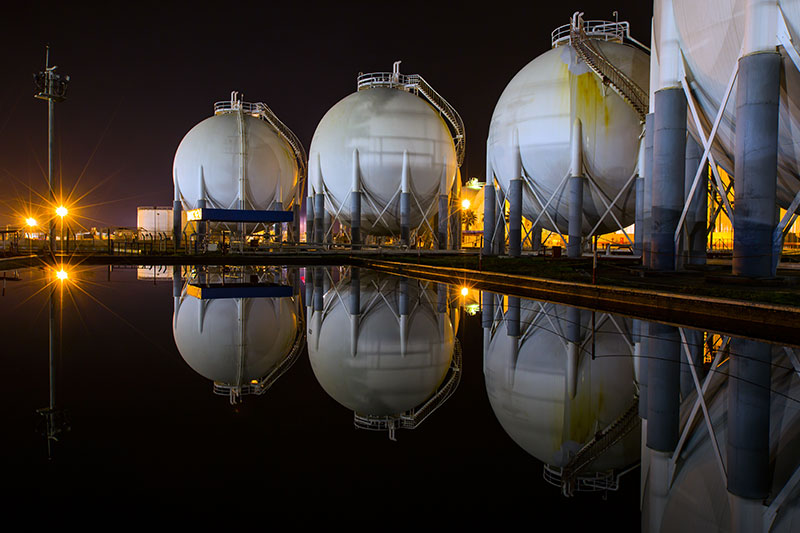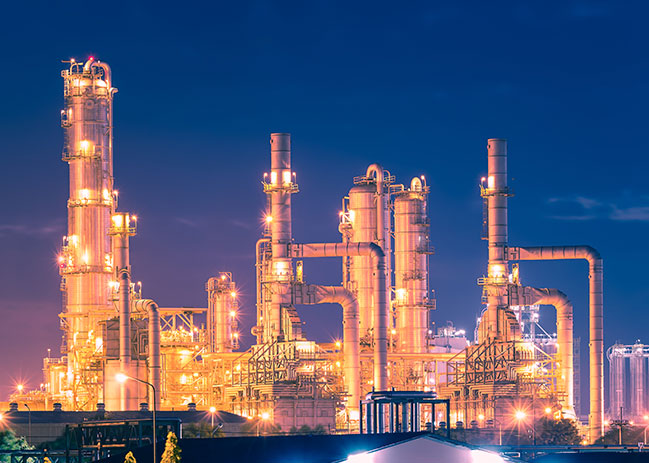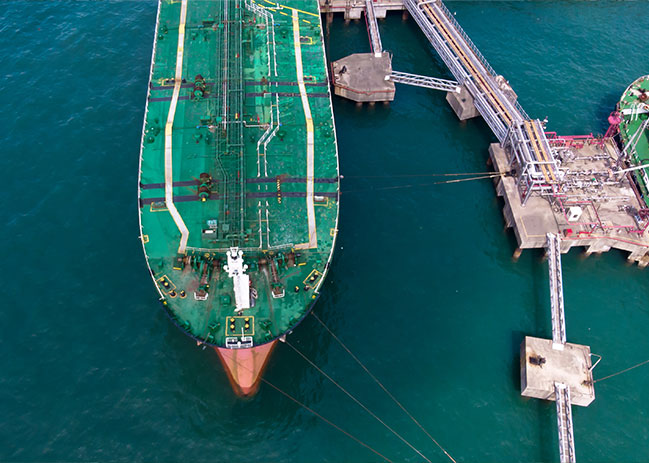
-
Liquefied Natural Gas 5542-87 (LNG)
Liquefied natural gas or LNG is natural gas (predominantly methane, CH4) that has been converted temporarily to liquid form for ease of storage or transport.
Natural gas is composed primarily of methane, with varying elements of ethane, propane, butane and the progressively heavier hydrocarbons.
Small quantities of nitrogen, oxygen, carbon dioxide, sulphur compounds and water may also be found.
Liquefied natural gas takes up about 1/600th the volume of natural gas in the gaseous state.
It is odorless, colorless, non-toxic and non-corrosive. Hazards include flammability, freezing and asphyxia.
Transforming natural gas into LNG is a complicated process.
The gas is first extracted and transported to a processing plant where it is purified by removing any condensates such as water, oil, mud, as well as other gases like CO2 and H2S and some times solids as mercury.
The gas is then cooled down in stages until it is liquefied. LNG is finally stored in storage tanks and can be loaded and shipped.
The liquefaction process involves removal of certain components, such as dust, acid gases, helium, water, and heavy hydrocarbons, which could cause difficulty downstream.
The natural gas is then condensed into a liquid at close to atmospheric pressure (maximum transport pressure set at around 25 kPa/3.6 psi) by cooling it to approximately −162 °C (−260 °F).
In simple terms natural gas that comes to the liquefaction plant from a production source is treated to remove impurities before being cooled to a temperature of -161°C.
The reduction in volume makes it much more cost efficient to transport over long distances where pipelines do not exist.
Where moving natural gas by pipelines is not possible or economical, it can be transported by specially designed cryogenic sea vessels (LNG carriers) or cryogenic road tankers.
The energy density of LNG is 60% of that of diesel fuel.
LNG SPECIFICATIONS: LNG GOST 5542-87 SPECIFICATIONS:
A. GROSS HEATING VALUE (VOLUME BASED)
Minimum: 1050Btu/SCF Maximum : 1170Btu/SCF
B. HYDROCARBON COMPOSITION AND NITROGEN CONTENT WITHIN THE FOLLOWING RANGE:
METHANE : 85.00 MOL % Minimum
UTANES AND HEAVIER :2.0 MOL % Maximum
PENTANES AND HEAVIER : 0.10 MOL % Maximum
NITROGEN : 1.00 MOL % Maximum
C. IMPURITIES WITH THE FOLLOWING RANGE :
HYDROGEN SULPHIDE : 4.8MG/Nm3 maximum
Total Sulphur: 28.0 MG / Nm3 Maximum
-
Liquefied Petroleum Gas (LPG)
Liquefied petroleum gas (LPG), also called LPG or LP Gas, actually encompases 2 main gases – propane (C3) or butane (C4) are flammable mixture of hydrocarbon gases used as a fuel in heating appliances and vehicles.
It is a clean-burning fossil fuel that can be used to power internal combustion engines. At normal temperature and pressure it is a gas but in a vessel under modest pressure it becomes a liquid. Varieties of LPG bought and sold include mixes that are primarily Propane or mixes that are primarily Butane.
LPG evaporates at normal temperatures and pressures. LPG is heavier than air and thus tends to settle in low spots, such as basements. This can cause ignition or suffocation hazards if not dealt with.
LPG-fueled vehicles can produce significantly lower amounts of some harmful emissions and the greenhouse gas carbon dioxide (CO2). The international standard is EN 589.
LPG is usually less expensive than gasoline, it can be used without degrading vehicle performance, and most LPG used in U.S. comes from domestic sources. In Australia, LPG (Propane) is virtually supplied to all homes and businesses.
LPG is supplied in gas bottles that are either exchanged or refilled on site by gas tankers. LPG (Butane) is supplied to specific businesses whereby it has advantage over Propane. These applications are normally related to greenhouse and use as propellant in aerosols.
The chemical formula for butane is C4H10. There is another mix -(Propane/Butane) called Autogas. This is the same LPG gas sold at petrol stations. Autogas LPG run vehicles and especially public bus and many private car owners have economic value as LPG cost is cheaper than petrol or diesel.
Another advantage is lower greenhouse gas emissions as compared with petrol or diesel. However the availability of LPG-fueled light-duty passenger vehicles is currently limited. A few light-duty vehicles—mostly larger trucks and vans—can be ordered from a dealer with a prep-ready engine package and converted to use propane.
Existing conventional vehicles can also be converted for LPG use. Since propane is stored as a liquid in pressurized fuel tanks rated to 300 psi, LPG conversions consist of installing a separate fuel system if the vehicle will run on both conventional fuel and LPG or a replacement fuel system for LPG-only operation.
-
Advantages of LPG
More than 90% of propane used in U.S. comes from domestic sources. Delhi (India) public transport bus service runs on LPG due to pollution issue.
In many countries now LPG driven public transport system is becoming mandatory. It is less expensive than gasoline. Low maintenance costs are one reason behind propane popularity for high-mileage vehicles.
Propane high octane and low-carbon and oil-contamination characteristics have resulted in greater engine life than conventional gasoline engines.
It is Environmentally friendly and reduces pollution with potentially lower toxic, carbon dioxide (CO2), carbon monoxide (CO), and non methane hydrocarbon (NMHC) emissions.
-
Disadvantages of LPG
There are still logistic issues. Limited availability (a few large trucks and vans can be special ordered from manufacturers; other vehicles can be converted by certified installers).
It is lesser readily available than gasoline & diesel however new infrastructure is being mobilized.
It has fewer miles on a tank of fuel. Typically in fleet applications, propane costs less than gasoline and offers a comparable driving range to conventional fuel.
Although it has a higher octane rating than gasoline rating (104 to 112 compared with 87 to 92 for gasoline), and potentially more horsepower, it has a lower Btu rating than gasoline, which results in lower fuel economy.
IDSM Group: Your Trusted LNG & LPG Gas Supplier
As a leading LNG & LPG gas supplier, IDSM Group provides top-quality liquefied natural gas and liquefied petroleum gas solutions for clients worldwide. With years of experience in the LNG and LPG industry, we have established ourselves as a reliable partner committed to delivering clean, efficient energy to meet your needs.
The Vital Role of LNG & LPG in the Energy Landscape
Natural gas is an incredibly versatile fuel source, able to generate electricity, heat homes and businesses, fuel vehicles, and more. When cooled to cryogenic temperatures, natural gas liquefies into a transportable liquid form known as LNG. This allows for the efficient storage and shipment of natural gas around the world.
LPG refers to propane and butane gases, which are byproducts of natural gas processing and crude oil refining. By pressurizing these gases, they can also be liquefied for convenient transportation and storage as LPG.
Both LNG and LPG offer clean-burning alternatives to dirtier fossil fuels like coal and oil. They produce significantly fewer carbon emissions, helping companies and countries transition to greener energy profiles. As demand for natural gas continues to grow globally, LNG and LPG provide flexible energy solutions.
Our Role as Your LNG & LPG Gas Supplier
As your trusted LNG & LPG gas supplier, our job is to consistently deliver liquefied natural gas and petroleum gas safely and efficiently. This involves:
- Sourcing natural gas and refinery byproducts for liquefaction
- Operating specialized liquefaction facilities to produce LNG and LPG
- Storing inventory in specially designed cryogenic tanks
- Arranging reliable transportation via tanker trucks, rail cars, or LNG carriers
- Coordinating on-time deliveries to client facilities and storage terminals
- Providing excellent customer service and support
Our liquefaction infrastructure and logistics capabilities allow us to handle everything from small LPG orders to multi-million gallon LNG contracts. IDSM Group aims to make procuring LNG and LPG a smooth, stress-free process for your business.
Key Factors Influencing LNG & LPG Pricing
As a commodity, LNG and LPG prices fluctuate daily based on supply and demand dynamics. Key factors include:
- Natural gas production and inventory levels
- Crude oil prices, which impact LPG markets
- Weather-related demand spikes for heating and electricity generation
- Infrastructure constraints like limited liquefaction and regasification capacity
- Geopolitical issues affecting export markets
We closely monitor these pricing factors and work to secure competitive LNG and LPG contracts. Our industry expertise helps clients budget and plan amidst fluid market conditions.
What to Look for in an LNG & LPG Gas Supplier
Choosing the right LNG and LPG gas supplier is crucial. Here are key considerations:
Consistent Product Quality – The composition and energy content of LNG and LPG shipments should adhere to strict quality standards. We test every batch to ensure specifications are met.
Reliable Delivery – Having LNG and LPG supplies arrive when needed is essential. Our operations and logistics teams work hard to prevent delays.
Flexible Contract Options – Suppliers should provide customized supply agreements to suit your business needs, from spot market purchases to long-term contracts.
Responsive Customer Service – Your supplier should be easy to reach and quick to respond when issues arise. Our dedicated account reps ensure your complete satisfaction.
Competitive, Transparent Pricing – Suppliers should provide competitive, transparent pricing and work to control costs. We leverage our purchasing power and infrastructure to deliver value.
Safety Record – Handling cryogenic liquids requires proven safety practices. We have an impeccable record of safe LNG and LPG operations.
FAQs
What services does an LNG & LPG gas supplier provide?
A full-service LNG and LPG supplier like IDSM Group handles natural gas sourcing and liquefaction, inventory storage, transportation logistics, and delivery coordination. This comprehensive approach ensures a steady, cost-effective supply of LNG and LPG.
How do I choose the right LNG & LPG gas supplier?
Look for an established supplier with proven liquefaction infrastructure, a strong safety record, satisfied long-term clients, transparent and competitive pricing, and a reputation for reliable, on-time delivery. Be sure to verify their quality assurance standards as well.
Can an LNG & LPG gas supplier handle large, complex projects?
With our extensive capabilities and resources, IDSM Group excels at managing major LNG and LPG supply projects. We have the technical expertise, infrastructure, and logistics experience to handle large, complex client requirements.
What are the benefits of long-term contracts with an LNG & LPG supplier?
Long-term contracts provide supply certainty at fixed, predictable prices. They also allow suppliers to reserve production and storage capacity for clients. At IDSM Group, we work closely with clients to develop customized long-term agreements that meet their needs.



